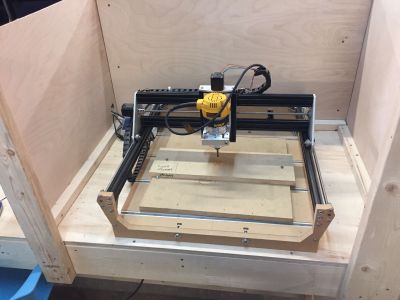Carve King CNC Router

NOTE - This router is no longer at the space.
The Carve King CNC router is on loan to the shop from Keech, starting in the fall of 2019. It is a "Carve King" by MillRight. NOTE - It's an original Carve King, not a Carve King 2. The vendor no longer makes it.
Overview
- This router is not sturdy; the frame will deflect when machining hard materials or at aggressive feed rates. Please do not use metal with this machine (just wood, plastic, foam, and other soft materials).
- This machine uses a hardware-store router. Speed "6" on the router dial is 16,000 RPM. There is no computer control of spindle speed.
- The router has a 1/4" collet. A 1/8" collet is available, but we don't have one; for now, use end mills and router bits with a 1/4" shank with this machine. You can get 1/4" and 1/8" end mills with 1/4" shanks.
- Table area is about 20" by 20". The maximum practical workpiece size is about 16" by 16" (perhaps slightly larger). Nominal vertical travel is about 5", but the actual maximum workpiece size is about 2" (1" for the spoilboard, 2" for the workpiece, 2" for clearance plus the end mill itself if entering the workpiece from the top).
- The upper cable guard will sometimes come loose and touch the X axis limit switch, causing the machine to stop. If the machine stops in the middle of the table, check to see if that happened.
Feeds and Speeds
The following settings have produced good results. If you try something new and it works, add entries at the bottom of the table.
Abbreviations: "fl" = "flute", "EM" = "end mill", "FR" = "feed rate"
NOTE: Up-cutting spiral end mills make smaller chips and clear them faster, but can leave a ragged edge at the top of their cuts. Straight-flute end mills are usually better for 2D work.
NOTE: Ramp rate and plunge rate should be half the feed rate or less. To be really conservative, ramp half and plunge a quarter.
NOTE: For a given chip load, a 1-flute end mill will go at half the feed rate of a 2-flute end mill. Count your flutes.
| Material | Tool | Depth Per Pass | Step-over | Router Dial | Feed (mm/min) | Feed (in/min) | User / Date | Notes |
|---|---|---|---|---|---|---|---|---|
| plywood | 1/4" 2-fl up-cut EM | 3 mm | 90% | "6" | 500 mm | 20 in | CJT fall 2019 | Decent results. |
| pink styrofoam | 1/4" 2-fl up-cut EM | 15 mm | n/a | "6" | 2000 mm | 80 in | CJT fall 2019 | Vacuum constantly to avoid chip welding. |
| wood (maple?) | 1/4" 2-fl straight EM | 6 mm | 3 mm | "4" | 150 mm | 6 in | CJT feb 2020 | Need straight-flute for decent finish. 300 mm (12 in)/min is ok for roughing. Can go faster along grain, but cross-grain will chatter. |
| HDPE | 1/8" 2-fl up-cut EM | 3 mm | 1.5 mm | "6" | 500 mm | 20 in | CJT feb 2020 | Up to 1000 mm (40 in)/min works fine. Slower than 500 mm (20 in) leaves crud on top edges. |
| Delrin | 1/8" 2-fl up-cut EM | 3 mm | 1.5 mm | "6" | 500 mm | 20 in | CJT feb 2020 | Up to 1000 mm (40 in)/min works fine. |
| ABS | 1/8" 2-fl up-cut EM | 3mm | n/a | "6" | 750 mm | 30 in | CJT july 2020 | Making cutouts in faceplates 1/8" thick without support. Keep plunge rates 250 mm (10 in) or lower to reduce deflection. |
| ABS | 90 deg v-bit | 0.8mm | n/a | "6" | 750 mm | 30 in | CJT july 2020 | Engraving lettering in faceplates. Keep plunge rates 250 mm (10 in) or lower to reduce deflection. |
Fusion 360 Notes
Fusion's post-processor for GRBL will sometimes generate code that the Carve King doesn't like. To prevent this, edit the following settings in the lower right part of the post-processing dialog:
- "G28 safe retracts" set to "no".
- "Output M6" set to "no".
- "Output tool number" to "no".
You may need to make additional changes to suppress "G18" and "G19" codes (working-plane changes):
- When setting up contouring operations, go to the "linking" tab and turn off "lead-in" and "lead-out". (This will leave rough spots on the workpiece due to plunging right next to the cut instead of coming in from the side, so only do it if you have to.)
Vectric Notes
As of 2020, you'll need to install a GRBL post-processor file to generate toolpaths that the Carve King likes from Vectric's software. These are ".pp" files that get installed to the "C:\Program Files (x86)\(program)\PostP" folder.
The post-processor files I'd found are cut-and-pasted here:
Hardware and Software Specs
- The hardware-store router is a DeWalt DWP 611.
- The machine's controller is FIXME: specific software package running on FIXME: specific hardware board. It speaks GRBL.
- The controller really doesn't like certain commands; in particular, it fails on tool changes (M6), operating plane selection (G17, G18, G19), and various other things (such as the "G28 G91 Z0" line Fusion likes to put in at the top). Edit the post-processed G-code to remove all instances of these if you're getting errors running your code.
- Use Universal G-Code Sender to talk to the controller.
- FIXME: Stepper motor and motor driver information goes here. The vendor page has it.